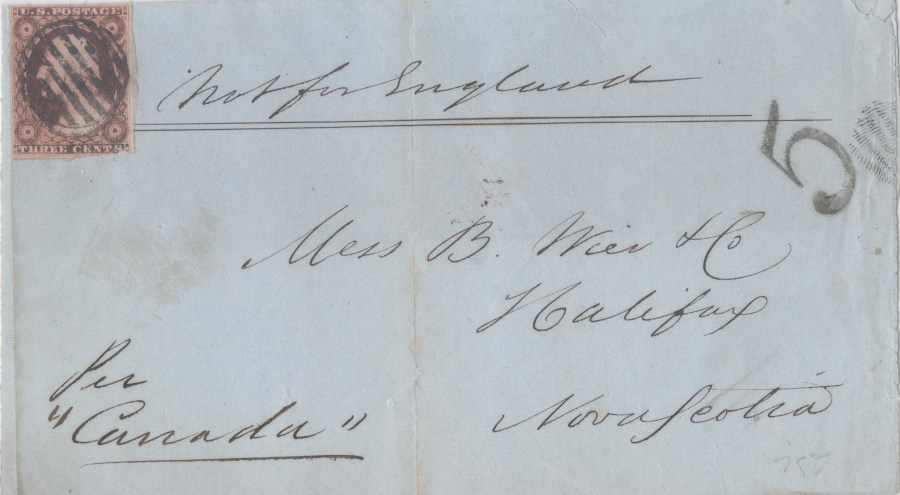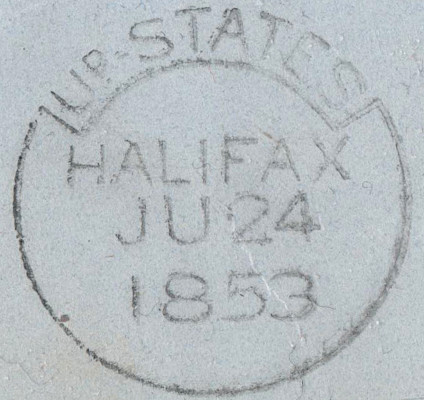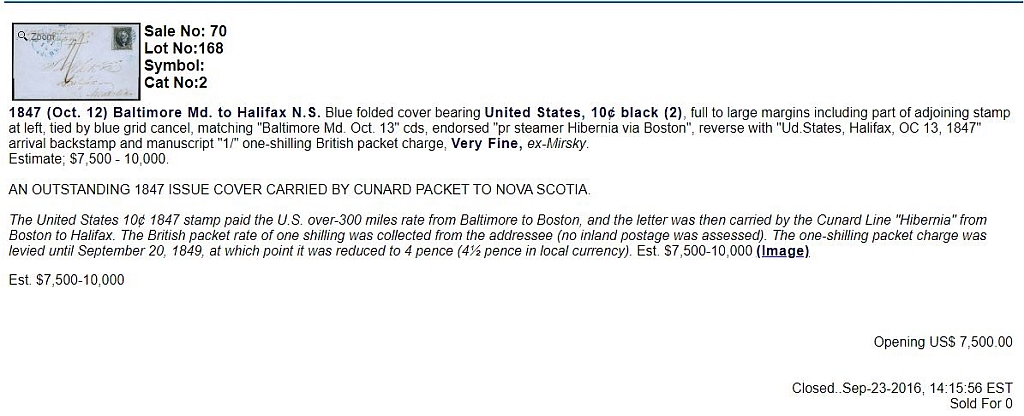|
|
Post by smauggie on Mar 26, 2020 10:03:33 GMT
Hi Folks, I bought this thinking that the marking was a US auxiliary marking but now that I look at it I think it is a Canadian rate marking. Can anyone confirm and/or provide additional info about it? Thanks!  |
|
JeffS
Member 
Posts: 2,844
What I collect: Oranges Philately, US Slogan Cancels, Cape of Good Hope Triangulars, and Texas poster stamps and cinderellas
|
Post by JeffS on Mar 26, 2020 13:31:38 GMT
While it has been years since my involvement in Canadian philately, several questions come to mind.
1. Does the US (imperforate?) really belong on the cover?
2. Why are no dispatch markings present?
3. Any original contents to identify the date of posting or origination?
4. Why the "Not for England" endorsement?
5. What was the proper postage ca 1851 to 1859 to Nova Scotia from the US?
Such handstamped "5" markings were internal Canada or Nova Scotia markings for a paid letter. Remember Nova Scotia was a province until 1868. Unpaid letters were typically marked "Unpaid 7."
My "gut" feeling is this was originally a rather ordinary and philatelically common cover (given the above stated questions) to which someone added a 3c imperf US issue.
To the left of the first line of the address I can make out staining which could be signs of a stamp removal.
The "Canada" endorsement is reminiscent of a ship or steamer name requesting carriage on the ship of that name. One might check the sailing dates of the named ship for further information, but without a proper date, that would be of no use.
Perhaps a collector with the proper literature could fill in the blanks. As I said, my comments are all from recollection.
|
|
kasvik
Member 
Posts: 607
What I collect: Cancels mostly, especially Sweden Gävle and Lidingö, Switzerland Geneva, Germany Pforzheim
|
Post by kasvik on Mar 26, 2020 14:12:33 GMT
Hi Folks, I bought this thinking that the marking was a US auxiliary marking but now that I look at it I think it is a Canadian rate marking. Can anyone confirm and/or provide additional info about it? I'm guessing its postage due, applied in the United States for collection by Canada Post/Nova Scotia. The stamp is an 1851-57, with a wonderful cancel. So this is pre-UPU; hell if I know how the bi-lateral rules worked then. Much depends on the US-Canada rates and whether there was doubling for postage due.
'Not for England' is amazing. Looks like someone wants to avoid repeating a very bad experience. |
|
|
|
Post by smauggie on Mar 26, 2020 15:10:31 GMT
JeffS: Well, I am pretty sure the stamp belongs on the cover. The "5" marking is in black ink which indicates postage due, not prepaid (which would be red). I think this was applied in Nova Scotia and not Canada as the stamp was used in the 1850's. It is a cover front, so there are no contents, sadly. I am not sure what you mean by dispatch markings. The stamp is cancelled with a typical killer of the time. the "not for England" marking is quite a mystery though.
|
|
renden
Member 
Posts: 9,162  What I collect: Canada-USA-France-Lithuania-Austria--Germany-Mauritius-French Colonies in Africa
What I collect: Canada-USA-France-Lithuania-Austria--Germany-Mauritius-French Colonies in Africa
|
Post by renden on Mar 26, 2020 15:31:41 GMT
JeffS: Well, I am pretty sure the stamp belongs on the cover. The "5" marking is in black ink which indicates postage due, not prepaid (which would be red). I think this was applied in Nova Scotia and not Canada as the stamp was used in the 1850's. It is a cover front, so there are no contents, sadly. I am not sure what you mean by dispatch markings. The stamp is cancelled with a typical killer of the time. the "not for England" marking is quite a mystery though. A little bit of history shows us the following: In 1848, Nova Scotia became the first British colony to achieve responsible government, and it federated in July 1867 with New Brunswick and the Province of Canada (now Ontario and Quebec) to form what is now the country of Canada.(Wikipedia) It seems to me normal that the sender of this letter wanted to be certain it was not shipped to England. |
|
|
|
Post by smauggie on Mar 26, 2020 15:46:07 GMT
Ok, stop the presses. I was sure it was a cover front, but I turned it over just now to find a part of the back. This settles the date, which is contemporary with the usage of the US stamp. I am not sure what UP-States means though.  |
|
stanley64
Member 
Posts: 1,985
What I collect: Canada, USA, Netherlands, Portugal & Colonies, Antarctic Territories and anything that catches my eye...
|
Post by stanley64 on Mar 26, 2020 16:12:50 GMT
Thanks for the posting smauggie ; postal history is a fascinating area and what a wonderful cover! Given your cover and the information shared, here a few more bits that might help with the identification and/or confirmation
The postal rate of the era was 3 cents up to 3,000 miles (see United States entries)
Maritime mail had there own special rates and tariffs such as this cover with its manuscript "5" of 1843
Although nothing definitive, a few more clues that might help with the riddle...
Happy collecting!
|
|
JeffS
Member 
Posts: 2,844
What I collect: Oranges Philately, US Slogan Cancels, Cape of Good Hope Triangulars, and Texas poster stamps and cinderellas
|
Post by JeffS on Mar 26, 2020 16:16:55 GMT
smauggie - I believe that marking is a bit smudged UD STATES
|
|
|
|
Post by smauggie on Mar 26, 2020 16:30:27 GMT
Thanks for the posting smauggie ; postal history is a fascinating area and what a wonderful cover! Given your cover and the information shared, here a few more bits that might help with the identification and/or confirmation
The postal rate of the era was 3 cents up to 3,000 miles (see United States entries)
Maritime mail had there own special rates and tariffs such as this cover with its manuscript "5" of 1843
Although nothing definitive, a few more clues that might help with the riddle...
Happy collecting!
Thank you Stanley. I think that black moire next to the 5 is a part of the marking. I think there is a book on these markings, but I can't get out to the library to look it up. |
|
Beryllium Guy
Moderator 
Posts: 5,912  What I collect: Worldwide Stamps 1840-1930
What I collect: Worldwide Stamps 1840-1930
|
Post by Beryllium Guy on Mar 26, 2020 21:36:18 GMT
The "not for England" marking is quite a mystery though. Hi, Antonio! Great to see you on TSF again.... it's been awhile! Actually, I think that the "Not for England" note is simple to explain: There is a town here in England, in West Yorkshire, called Halifax. So, I think that the note is simply there to make the distinction that the recipient of the letter is in Halifax, Nova Scotia and not Halifax, England. Don't know for sure that this is right, but it's just my common sense at work! -Chris    |
|
JeffS
Member 
Posts: 2,844
What I collect: Oranges Philately, US Slogan Cancels, Cape of Good Hope Triangulars, and Texas poster stamps and cinderellas
|
Post by JeffS on Mar 26, 2020 23:59:25 GMT
@beryllium Guy - that was really helpful, thanks
|
|
kasvik
Member 
Posts: 607
What I collect: Cancels mostly, especially Sweden Gävle and Lidingö, Switzerland Geneva, Germany Pforzheim
|
Post by kasvik on Mar 27, 2020 1:20:40 GMT
The "not for England" marking is quite a mystery though. Hi, Antonio! Great to see you on TSF again.... it's been awhile! Actually, I think that the "Not for England" note is simple to explain: There is a town here in England, in West Yorkshire, called Halifax. So, I think that the note is simply there to make the distinction that the recipient of the letter is in Halifax, Nova Scotia and not Halifax, England. Don't know for sure that this is right, but it's just my common sense at work! -Chris   
|
|
Beryllium Guy
Moderator 
Posts: 5,912  What I collect: Worldwide Stamps 1840-1930
What I collect: Worldwide Stamps 1840-1930
|
Post by Beryllium Guy on Mar 27, 2020 7:44:43 GMT
Thanks for your positive comments, Jeff ( JeffS) and Aaron ( kasvik)! I love to solve puzzles, figure things out. It occurs to me that we need someone to come up with a good brain teaser.... I love those. Michael ( Londonbus1), you have done those before. Anything occurring to you? This would be an excellent time for a teaser to solve, with people everywhere cooped up inside. Aaron said: Best ever? Wow! Aw, shucks.... lil' ol' me? OK, if you insist, any/all prizes accepted. Ha ha ha    |
|
vikingeck
Member 
Posts: 3,551
What I collect: Samoa, Tobacco theme, Mail in Wartime, anything odd and unusual!
|
Post by vikingeck on Mar 27, 2020 13:05:29 GMT
I was delayed yesterday in responding to this but I was going to suggest that the Halifax N.S. Was named after the original English city of Halifax and so the “Not for England “ is as Chris has said is to make sure it doesn’t make its way across the Atlantic in error.
the UD. STATES. HALIFAX date stamp on the reverse strikes me as a bit unusual since HALIFAX is certainly not in the US , I am going to suggest it is a special cancel used on Maritime mails ie a ship letter mark.
I wonder if the “5” will be a ship letter charge? This is speculation but it is the sort of thing we find on European mail around this time .
i believe there was much competition for carriage of mail between various US , Canadian and GB shipping companies and rates varied depending on which ships actually carried mail , Transatlantic mail rates were complicated and seem to have changed frequently as the charges dropped over the decades 1830-1870 pre Universal Postal Union times.
|
|
renden
Member 
Posts: 9,162  What I collect: Canada-USA-France-Lithuania-Austria--Germany-Mauritius-French Colonies in Africa
What I collect: Canada-USA-France-Lithuania-Austria--Germany-Mauritius-French Colonies in Africa
|
Post by renden on Mar 27, 2020 14:29:21 GMT
Beryllium Guy........Halifax, UK - why did I not think of that - You are a great "solver" Chris !! Thanks René
|
|
JeffS
Member 
Posts: 2,844
What I collect: Oranges Philately, US Slogan Cancels, Cape of Good Hope Triangulars, and Texas poster stamps and cinderellas
|
Post by JeffS on Mar 27, 2020 14:35:59 GMT
Given that the original presentation mentioned no backstamp, my mind took me to a letter mailed during the decimal stamp period. That was an inaccurate supposition.
The UPU had nothing to do with setting mail rates between the US and Canada and provinces.
The UD STATES postmark is an exchange office marking applied in Halifax. Exchange offices determined the percentage of postage that the destination country could claim. These were tallied over a period of time and sent to the US for payment.
I seriously doubt that the smudge to the right of the numeral 5 is an integral part of the marking. There is no reason to have a grid canceler attached to a rate marking not intended as a postmark. Looks more like an inked thumb print.
Perhaps a knowledgeable student of the subject can look up what the rate should have been and determine what value the missing stamp might have been. I am not convinced that the 3c stamp belongs on the cover and speculate the possibility that two stamps were soaked from the cover and at a later time, someone tried to salvage the cover by adding the 3c stamp.
I haven't collected Canada postal history for 20+ years and my library has been disbursed. I acknowledge I might be wrong on the 3c stamp. So someone needs to determine the value of the missing stamp (3c + ?) if the 3c is legit.
A posting at Frajola's board would bring a quick and accurate answer.
|
|
tomiseksj
Moderator  Woodbridge, Virginia, USA
Woodbridge, Virginia, USA
Posts: 6,385  What I collect: Worldwide stamps/covers, Cinderellas, Ohio Prepaid Sales Tax Receipts, U.S. WWII Ration ephemera
What I collect: Worldwide stamps/covers, Cinderellas, Ohio Prepaid Sales Tax Receipts, U.S. WWII Ration ephemera
|
Post by tomiseksj on Mar 27, 2020 14:39:12 GMT
This listing from a Schuyler Rumsey auction may shed some light. By July 1, 1851, the 1/2 ounce U.S. domestic letter rate was set at 3 cents. From the description of the British packet rate described in the listing, I am assuming that the "5" reflects the amount due from the addressee. I am also assuming that the Ud States/Halifax is a receiving mark indicating the cover's point of origin (i.e., Unite d States).  |
|
kasvik
Member 
Posts: 607
What I collect: Cancels mostly, especially Sweden Gävle and Lidingö, Switzerland Geneva, Germany Pforzheim
|
Post by kasvik on Apr 26, 2020 18:24:08 GMT
Anyone know the A.x. marking? It's not rare, but beyond me. Applied in Canada, I'm guessing. renden , Beryllium Guy , brightonpete , stanley64 , jimjung , cindycan2 ?
I haven't bought this one yet, and might not. Another of those affecting letters to the ICRC; initial contact to find someone the sender hoped was taken prisoner. As always, except for mass surrenders like the fall of Singapore or the early months of the German invasion of the Soviet Union, the odds were poor. This time maybe they were lost in the Battle of the Atlantic, or maybe after Dieppe raid the year before, and someone sent a hopeful word. Sometimes I'm not strong enough to be a good collector.

|
|
renden
Member 
Posts: 9,162  What I collect: Canada-USA-France-Lithuania-Austria--Germany-Mauritius-French Colonies in Africa
What I collect: Canada-USA-France-Lithuania-Austria--Germany-Mauritius-French Colonies in Africa
|
Post by renden on Apr 26, 2020 21:46:50 GMT
Never seen A.x. on a cover and have not done any research - Sorry |
|
tomiseksj
Moderator  Woodbridge, Virginia, USA
Woodbridge, Virginia, USA
Posts: 6,385  What I collect: Worldwide stamps/covers, Cinderellas, Ohio Prepaid Sales Tax Receipts, U.S. WWII Ration ephemera
What I collect: Worldwide stamps/covers, Cinderellas, Ohio Prepaid Sales Tax Receipts, U.S. WWII Ration ephemera
|
Post by tomiseksj on Apr 26, 2020 22:14:13 GMT
Anyone know the A.x. marking? It's not rare, but beyond me. Applied in Canada, I'm guessing. ...
Based upon the below found on page 24 of the Military Postal History Society Bulletin 3, 2015, I'm going to assume that the marking was applied in Paris (then under German control) on its way to Geneva.
|
|
JeffS
Member 
Posts: 2,844
What I collect: Oranges Philately, US Slogan Cancels, Cape of Good Hope Triangulars, and Texas poster stamps and cinderellas
|
Post by JeffS on Apr 26, 2020 23:48:34 GMT
@kasvik - The encircled A.X. marking is German censorship, an explanation taken from the internet:
A.x. to show that it had been dealt with by the German censors. The A stands for Ausland Brief Prufstelle which translates as: Overseas Letter Censor Office while x is the German censor code for Paris. Such mail was dealt with in Paris.
|
|
|
|
Post by sherro on Apr 27, 2020 2:36:58 GMT
Definitely a German censor mark. I have this cover which shows the Ae mark of Frankfurt
 |
|
kasvik
Member 
Posts: 607
What I collect: Cancels mostly, especially Sweden Gävle and Lidingö, Switzerland Geneva, Germany Pforzheim
|
Post by kasvik on Apr 27, 2020 13:54:22 GMT
Definitely a German censor mark. I have this cover which shows the Ae mark of Frankfurt
Looks like trans-Atlantic surface mail to Geneva went through a channel port to Paris for forwarding. Judged from the scan, no sign it was re-opened; it would looked wrecked. Just the dismissive A.x.; the Paris censor office must not have cared. Thanks tomiseksj , JeffS , sherro , renden . Now I should buy it. |
|
|
|
Post by sherro on Apr 27, 2020 13:59:03 GMT
My pleasure
|
|